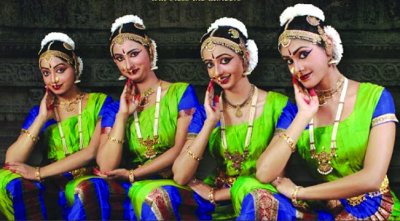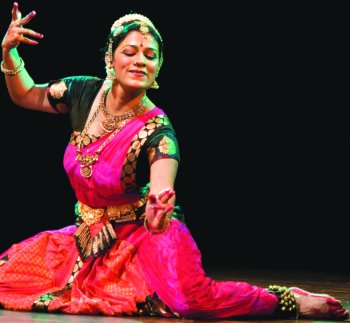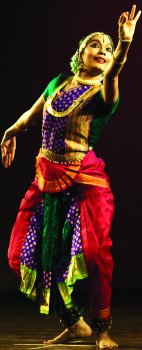
|   |

|   |
Captivating dance presentations - Dr. M Surya Prasad, Bangalore e-mail: drmsuryaprasad@gmail.com December 29, 2012 One of the important staples of Bengaluru’s cultural scenario for musicians, dancers and connoisseurs for the past few years, Ananya’s Nrithya Neerajana has had quite a good number of dance performances enjoyed by avid rasikas. Dr. R.V. Raghavendra and his team comprising of young dancers deserve to be commended for the way it was planned and executed. The 4th edition of Nrithya Neerajana was held on December 22 and 23, 2012 at the Seva Sadan auditorium. The intensity and converging energies of both audience and dancers in an intimate atmosphere was remarkable. On the concluding day, seasoned and a highly sensitive exponent of Bharatanatyam, Satyanarayana Raju was felicitated with Ananya Puraskar. A befitting honour indeed! Excellent group choreography  The inaugural dance recital was presented by the well trained disciples of Satyanarayana Raju. It was nice to see them shining separately and together. By now a well established quartet, Chaturgamini comprising of Adithi Sadashiva, Gowri Sagar, Prithvi Sharma and Anju Nair did their guru proud in graphically sketching the glory of Goddess Saraswathi on the basis of Saaramathi Saraswathi Vani. Prefaced by a shloka Saraswathi namasthubhyam, a vivid imagery of Devi drawn individually and in concert by the young dancers enthralled the rasikas. The excellent group choreography and its neat execution won instant approval of the audience. Vibrant nritta marked by swaras, jathis and adavus was interlaced to make it livelier. Young boy Shishir as Krishna, Nikitha, Prithvi and Anju danced with happy abandon to interpret the familiar Krishna Naamaavali in the varnam format. Gopa Gopeeshwaro (Reetigowla) was filled with attractive nritta, nrithya and abhinaya. Sequences drawn from the Krishna tale and the Geetopadesha were reenacted in quick changeovers. Animated Bharatanatyam  Well equipped Anuradha Vikranth’s Bharatanatyam was vigorous and animated right from the beginning. Sans hype or exaggerated histrionics, the dancer gave her best in all aspects of her dance form. Gifted with communicative face and eyes, Anuradha covered the entire stage in alluring geometrical patterns. There was feminine grace and lyricism too. She began with a Kannada varnam Neela megha Shama set to ragamalika woven around Krishna theme and focusing on a virahothkhanditha nayika. I would accord full marks to her dance which caught the trembling sentiments of the nayika. Reminiscing about the raasa leela of Krishna, the heroine gets lost into that mood in Ninna raasa leeleya neneyutha. This was artistically shown by her. Suffice it to say, Anuradha visualized with aplomb the taut nritta (to the accompaniment of taana) attached to the delineation. She was also at home in capturing the essence of the navarasas. The charana part Ananda sukhava needi baareya in a lively pace was crisp. In the portrayal of a Dasara pada Tamboori meetidava (Sindhubhairavi) the artiste was totally engrossed. One liked to watch her keeping intact the vaachikaabhinaya throughout her recital. She was ably supported by Suryanarayana Rao (nattuvangam), Balasubramanya Sharma (vocal), Narasimhamurthy (flute) and Gurumurthy (mridangam). Grand premier of Yagyaseni  The premier of Yagyaseni (another name of Draupadi), a solo presentation choreographed by young, talented, ambitious and zealous Bharatanatyam dancer Gayathri Sriram of Singapore was a grand success and won the approval of the rasikas. Inspiringly supported by Guru Minal Prabhu (this year’s winner of the Karnataka Sangeetha Nrithya Academy award) on nattuvangam, Sharma (music and vocal), Gurumurthy (mridangam) and Jayaram (flute), Gayathri explored the changing emotional highs and lows of a woman. With Draupadi as the pivotal character the dance visualization of her saga full of travails and trauma, her notions about the Pandavas and their traits and behaviour et al, in the form of a dialogue between her and Krishna, carried the feel for poetry and passion. A deep seated serenity even in the tortured moments, sensitivity and a consciousness of woman’s vulnerability and generosity which can be exploited could be sensed throughout in the execution of the piece. With her beautifully balanced body, Gayathri moved with poise and grace and also demonstrated the capacity for deep inner involvement which however never went out of control. Delightful in the portrayal and aided by the voiceovers (Krishna and Draupadi dialogue) the rendition had the audience glued to their seats. The presentation began with an Agni Jathi interspersed with Pavan Verma's sonnets. There was never a dull moment. The recital ended with a mangalam to Yagyaseni and Krishna. Proficient male dancer  Gliding along in stately dignity, leaping, moving in delight - it was an interplay of a variety of attitudes and movement when Guru Satyanarayana Raju performed and brought down the curtains on Nrithya Neerajana 4. Almost obsessively orthodox and pure, never straying beyond the traditional format, the proficient male dancer sent lovers of dance into raptures. His clean movements and scrupulously correct adavus were laced with the added advantage of a perfect rhythmic sense, thanks to his unflinching commitment and dedication to dance. With effective support lent by Shakuntala Prabhath (nattuvangam), Karthik Hebbar (vocal), Narasimhamurthy (flute) and Lingaraju (mridangam), Satyanarayana Raju’s Ashtaragamalika Varnam Saami ninnekori received extensive treatment, both in the rhythmic and mimetic passages. The nritta was full of verve and tautness. His abhinaya for Ee teeruga (Bhadrachala Ramadas, depiction of Gajendra moksha, Shabari moksha) was excellent. The concluding Ratipatipriya tillana was of high class. Dr. M. Surya Prasad is a well known Academy awardee dance and music critic. He is a regular columnist for Prajavani (every Tuesday) and The New Indian Express (every Monday). He has published more than 4500 articles and completed more than 1300 columns of writing in English and Kannada. He is the Professor and Head of the Dept. of Hindi, Vijaya College. |